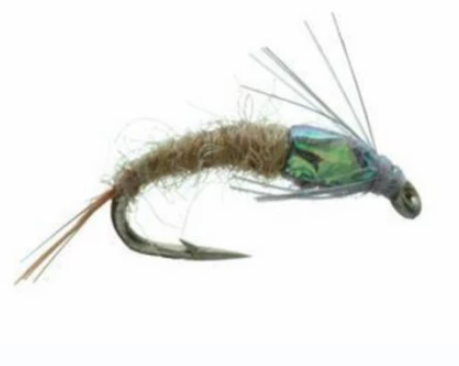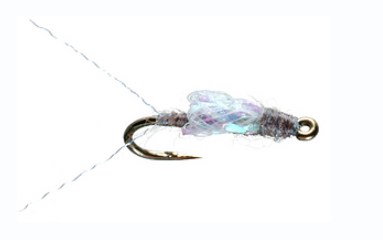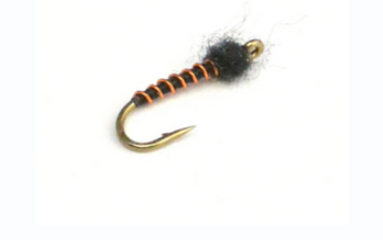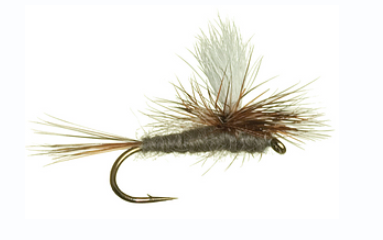As we transition from summer to fall, it’s time to start reevaluating our fly selections. As we enter the fall season, most of the summer hatches subside and trout begin to key in on a few specific bugs. It is common to see multiple mayfly hatches, such as red quills and tricos, carry through September, but BWOs will be a key food source for trout through mid-November. Midges are another primary food source for trout throughout the fall. So, if you haven’t pulled out your tiny midge nymphs since last spring, it’s time to dust them off and check your bi-focal prescription. The yellow stonefly hatch typically concludes by mid-September, but don’t rule out the large stonefly/terrestrials patterns just yet. Until we receive consecutive nights of below freezing temperatures, we will still see decent terrestrial activity.
There are many patterns that effectively imitate BWOs, midges and terrestrials. So to help you narrow your search, we highlighted some of our favorites.
Nymphs
Barr’s Emerger: The Barr’s Emerger is a highly effective baetis pattern tied by John Barr. Depending upon the color, this pattern effectively resembles a PMD and BWO. PMD hatches carry through the first few weeks of fall and the BWO hatch is a primary fall hatch, so this pattern will help you cover both fronts. The Barr’s Emerger is also tied in a flashback version, which we find particularly effective on freestone rivers. Tailwaters however, we like to fish the original version. If you’re running a double baetis nymph rig, we like to use this pattern as the lead fly above a more prominent emerger pattern.

RS2: In case we haven’t said it enough, we’re going to say it again - BWOs are a primary food source for trout throughout the fall. As such, the RS2 pattern is a must have in your fly box. The original pattern was created by Rim Chung and since then, fly tiers have made adjustments that make it an irresistible fly during various mayfly and even midge hatches. As an emerger, the RS2 is most effectively fished as the trailer fly on a nymph or dry dropper setup. Allowing your line to swing and the fly to rise through the water column will imitate an emerging BWO, trico or midge. Personally, we find that black RS2s are most effective during the morning and grey/olive are more productive during the late morning and early afternoon. With cooling air and water temperatures, RS2s in size 20 – 22 will be the most effective during the fall.

Black Beauty: Whoah Black Beauty bam-ba-lam, whoah Black Beauty. Can’t tell you why, but that runs through my head every time I tie one of these on. If this has never happened to you, I apologize if those lyrics pop in your head next time you’re fishing a Black Beauty. While this midge pattern is a staple year-round, we tend to increase its usage during the fall and winter. This is a simple pattern that consists of black thread, wire and dubbing. Alternative versions can be found with a clear bead head. The bead head effectively resembles an air bubble from an emerging midge and trout can’t seem to resist it. Another effective version is the Mercury Midge, which is tied in white instead of black thread and has a clear bead head. A Black Beauty is effective as a lead or trailer pattern on a nymph rig. Size 22 – 24 patterns will be the most effective during the fall.

Egg: I know, I know. An egg technically isn’t a nymph but it is an incredibly productive pattern to use during the fall. During the brown trout spawn, rainbows and other brown trout go crazy for eggs. It’s not uncommon to see rainbow trout sitting below a redd waiting for eggs to float their way. There are many egg patterns to choose from and depending upon the kind you select; you can use it various ways. If you’re fishing with an egg made of yarn, it can be highly effective as a lead attractor pattern on your nymph rig. If you’re using a bead/peg egg, tie it no more than one inch above your trailing nymph (we prefer to use a simple thread midge for this setup as opposed to a bare hook). Tying the bead egg too high above your trailing nymph will increase your odds of snagging the fish, which isn’t a good thing.

Dry Flies
Hippy Stomper: Big foam patterns are all the rage during the summer, but what some anglers don’t realize, is patterns such as the Hippy Stomper, continue to be highly productive through the beginning of fall. Terrestrial activity continues until there are at least two consecutive nights of freezing temperatures, so don’t put these away yet! The hippy stomper is most effective when fished along the bank. The aggressive takes this pattern encourages is an absolute blast to experience. Another reason we love this pattern is its buoyancy. Trailing emergers, searcher patterns and worms behind this pattern is highly effective if trout aren’t feeding on the surface. If your nymph isn’t getting deep enough, fear not, you can trail a second nymph below this pattern or even add a small split shot to your line. Even if trout aren’t feeding on the surface, this is a great setup to fish shallow sections and rivers during the fall.

Parachute Adams: Depending upon the size, the Parachute Adams is a versatile dry fly pattern that imitates BWOs and midges. If you’re stuck in a heavy midge hatch and trout don’t respond to a midge specific pattern, tie on a size 24 Parachute Adams. During a BWO hatch, you can size up to a #20, but If the trout don’t respond, drop the size down to 22 or 24. If you can keep your eye on this tiny pattern, you’ll find plenty of success when trout are feeding on the surface.

